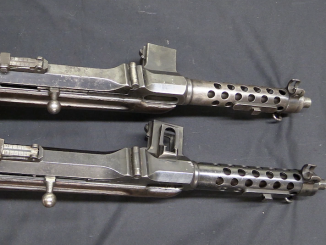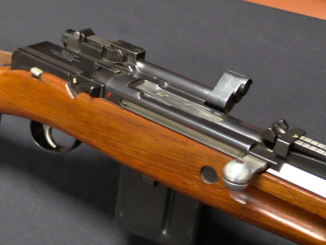Best known as the first semiautomatic service rifle adopted by a mainstream military force, the 1908 Mondragon was designed by Mexican native Manuel Mondragon, manufactured by SIG in Switzerland, and adopted by the Mexican Army (Ejercito Mexicano). The adoption was short lived, however, as the guns proved unreliable with the low-quality 7mm Mauser ammunition made in Mexico at the time (although they ran fine with high-quality European ammo).
After a partial delivery, Mexico refused to pay for or accept delivery of more, and this left SIG in an awkward position. They would try to sell the rifles for several year, including an attempt to market them to Germany during WWI as aviators’ rifles, with detachable magazines and brass-catching bags. No significant purchases resulted, though.
In this video I will examine 4 different examples of the Mondragon:
- A prototype 1900 model self-loader, which uses the 1908-style action but with en bloc clips instead of stripper clips
- A Mexican-issue 1908, complete with bipod and spade bayonet
- A 1908 rebarreled in 8mm Mauser and send to Germany during WWI
- A standard 1908 updated by SIG and never sold




Poor Mondragon didn’t get his design to work with non-ideal ammunition… And thus combined with the price tag, the ammunition issue threw the rifle into relative obscurity.
Well, the same could be said of the original M-16, which just wouldn’t work with ball powder. And the FAL isn’t exactly tolerant of fouling, either, even with the gas port opened up all the way.
Gas-operated systems are inherently ammo-sensitive, or more exactly powder-sensitive. Generally, the cleaner-burning the powder and the closer it matches the pressure curve that the system was designed around, the better.
I’ve long suspected that it was dissatisfaction with ammunition quality and powder residue that caused John Browning to largely forsake gas operation after the BAR and concentrate on recoil operation in the .30 and .50 caliber MGs, after starting out with gas operation on pretty much everything bigger than a handgun. Even the 37mm M1/M4 aircraft cannon was (long) recoil operated. (The hydraulic buffer tube under the barrel just makes it look like it’s gas-operated.)
cheers
eon
“John Browning”
Don’t overlook other gas-operated weapon: Colt Potato Digger
It looks somewhat peculiar (from our point-of-view) design:
it has not gas tube and gas piston like most gas-operated, but only hole in barrel wall, powder gases go through that hole and hit lever, lever movement cycles action.
You can see lever movement during firing:
https://www.youtube.com/watch?v=4cK_-VMk2hU
hence it is named Potato Digger, notice that because there is not gas tube there is very little place when foul can collect.
Later Colt Potato Digger was redesigned with typical gas system to become Marlin Model 1917 and Marlin Model 1918, these guns were used as aircraft machine gun and tank machine gun. I am not aware about any complaints on reliability of this guns, but notice that there were over 20 years of difference, so I suspect that smokeless powder quality was improved through that time.
Although generally credited to Browning (basically the mechanism of his first gas-operated pistol design turned upside-down and enlarged), the “Potato Digger” probably owed at least as much to the work of Carl J. Ehbets, Colt’s chief designer, whose own early self-loading pistol prototypes used a very similar gas-operation cycle;
https://s-media-cache-ak0.pinimg.com/736x/64/98/15/64981535efc022a27188f6d547dd179e.jpg
http://www.google.com/patents/US580935
Ehbets also patented an earlier design which was also gas-operated, with a magazine feed system which closely resembled that of the early Bergmann models;
https://www.google.com/patents/US570388
It used a gas piston instead of a “swing arm”, and may have been inspired by the French Clair brothers’ patent of 1893;
https://www.forgottenweapons.com/clair-automatic-pistol/
In the end, the gas piston system would prove to be the overall most common way of applying gas pressure to the operating cycle of a firearm.
Mannlicher built and patented a gas-piston operated rifle in 1895, with an action very like that of the later American M1 Garand. They were a year behind Ehbets and two years behind the brothers Clair.
cheers
eon
Thank you Ian.
Most interesting and fascinating.
Got any idea what any of the four would go for on the competitive retail market?
Has any of your readers noticed that those shipped to the Federalistos Mexicanos are now in Mexican museums?
Regards
Pat
Not sure if you read a previous post. The Mondragon prices range from a crappy gun around $10,000 to the Diaz gun probably around $100,000. None of the issued weapons are accounted for. Presentation models are the one seen in the museums.
The Swiss Air Force purchased 50(other sources say 40) Mondragon 1917 Rifles in Caliber 7.5 Swiss (GP11) in 1917, with detachable 12 round double row magazines. The Air Force Designation was ‘Fliegergewehr 1917’ (lit. Aircraft Rifle 1917)from where the Designation ‘Mondragon 1917’ obviously stems. But according to my sources SIG demonstrated the rifle to Air Force officers as early as September 1915, the allocation of funds (11’000 Francs for 50 rifles) dates from March 3rd 1916.
Again according to my sources SIG DID sell a number of rifles to Germany, where they were designated as Flieger-Selbstlade-Karabiner 15 (lit. aircraft self loading carbine Mod. 1915), but I could not find out how many were sold.
It is therefore almost certain that SIG had the rifle ready far earlier than 1917, maybe as early as the outbreak of the war in 1914. This would make sense, as an automatic rifle for aircraft use would be acceptable in 1914, but more than obsolete in 1917 – and stupid they were not at SIG at that time.
BTW: Another reason the Mexican Army opted out of the contract might be the outbreak of the Mexican Revolution in 1911, which ousted Porfirio Diaz who left the country. SIG might have found themselves without a paying customer in 1911…..
Very kind regards Peter
Good points, Peter. No customer, no sales. I just can’t understand why SIG didn’t find a way to simplify construction and improve reliability.
SIG offered 500 Mandragon semi-auto rifles to Serbia in 1913-early 1914, as only country in Europe that used 7x57mm. It was rejected however as money was tight, and no rifles were ordered even for testing. Hence, only semi-auto rifle that was tested by Serbia before WW2 was unknown Mauser model in 7x57mm, tests noted that rifle was very unreliable even in clean conditions (it did not even get to endurance testing).
I would like to bring a couple of important points to light. The number of Mondragons has been estimated from a few thousand to over 1,000,000 (bad info on Wikipedia and cruffler) in fact the highest known serial number is in the 3600 range, which lends credence to the 4000 number. All the guns sent to Germany were wiped clean of all Mexican markings. None of the original Mexican guns has ever surfaced. There are no known 8mm versions. The only calibers, on the model 1908, are 7mm Mauser, 7.65, 7.5 Swiss and Mr Diaz’s gun reportedly in 30-30. The one described in the video is actually 7.5 Swiss and it has a 10 round magazine, same as the 7mm version. Single stack vs double stack. They will both accommodate 2 stripper clips which makes sense to the soldier in the field. The brass catcher on the Swiss rifles wasn’t to protect the crew from hot brass , it was to protect the propeller on aft facing engines. The gas release moves fore and aft, not left to right. The “safety” on the charging handle was an after thought. Any semi auto, including M16, AK or garand can be used as a straight pull rifle. The problem is overcoming the return spring after each shot. Disengaging the return spring will allow for very rapid reloading. The FSK15 aviation use gun differs only in a special catch to hold a 30 round drum magazine. Those 4 guns are worth between $150-$200k
Interesting that they changed from a dove tailed charging handle guide in the early guns to what looks like a T-slot in the last one.
Also how much of the energy from firing is sustained by the barrel as opposed to the locking lugs/bolt/other parts? 7x57mm to 8x57mm is around a 50% increase in muzzle energy, makes me wonder if other components were (or should have been) changed with the caliber switch.
An excellent presentation and homage to Manual Mondragon, man ahead of his time. Thanks.
Going back to the Tanner article (that I’m sure you’re tired of hearing about by now);
1. Diaz’ engraved M1908 is in the Museo del Ejercito Mexicano. It is serial number 1, in .30-30 WCF. At the time, all documentation on the rifle refers to it as “Fusil Porfirio Diaz’, Sistema National”, giving Mondragon no credit at all. But the presentation rifle itself has “Modelo Mondragon” inlaid in gold on top of the barrel just behind the front sight.
2. The gas cutoff had a very practical purpose; grenade launching. See Man At Arms magazine, October 2015, “The Employment of Rifle Grenades During the Mexican Revolution” by James B. Hughes, pp. 25-26.
The grenades in question were the “Hale’s patent” rod-pattern grenades made by the Cotton Powder Co., Faversham, Kent. They had a 7mm brass rod 27.36″ long, a cylindrical brass body 1.3125″ diameter by 5.5″ long, a cast iron fragmentation sleeve near the “nose”, and were filled with a charge of Tonite (a CP Co. “patent” explosive- actually, a mixture of guncotton and barium nitrate) fired by an inertial impact detonator.
These grenades were designed to be launched from the Mexican 7mm Mauser bolt action service rifle. They could have also been used from the 7mm M1908 semi-automatic rifle, in which case the need for the gas cutoff is obvious; to avoid wrecking the gas system with the increased pressure of the blank grenade-firing cartridge lofting the rodded grenade.
The gas cutoff does manually what the cutoff plug on the grenade spigot launcher for the M1 Garand does automatically when you attach it to the rifle and lock it to the bayonet lug. I imagine anyone who forgot to flip the lever around in drill got a thorough chewing out by the CO. (Like most Second and Third World armies, the Ejercito de Mexicano was notably lacking in experienced noncoms, hence most jobs normally done by E-5s etc. had to be done by commissioned officers.)
3. The trowel bayonet can be recognized as unique to the Mondragon M1908 because it has the words “MADURA” (“wood”) and “HIERRO” (“iron”) in block caps stamped into the blade. Exactly why, no one seems to know. The metal sheath for the bayonet also houses a two-piece rifle cleaning rod similar to the standard Mauser rod.
4. After Diaz went down and Madero succeeded him in 1911, General Mondragon was appointed Minister for War. He left the post when Madero was “deposed” by Gen. Victoriano Huerta in 1913, retiring to Spain, where he passed away in 1922 at age 74.
BTW, Mondragon had the last laugh. Huerta was deposed in 1914, was arrested in Texas for plotting against the Mexican government a year later, and died in U.S. custody in El Paso in 1916.
(Source; Funk & Wagnall’s Encyclopedia, 1955 ed.)
cheers
eon
Its “MADERA” not “MADURA”
Accent on the second o, not the a. Mon-dra-GON.